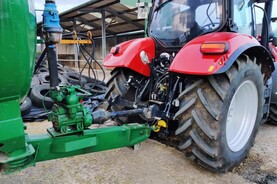Calving is a busy time on all beef farms and with the part-time nature of the enterprise for many with full- or part-time off-farm employment, anything that makes things easier should be explored.
Working long hours combined with long nights in the calving shed will wear anyone down over a period of time and this is when accidents, farm or otherwise, are more likely to happen.
Getting five or six hours of sleep at night is necessary for most to be able to function adequately over a long period of time.
While there are many high-tech calving monitors, sensors and cameras that are a great help in their own right, there is one, simple, scientifically proven way to reduce the number of night-time calvings and it comes at zero cost to the farmer.
Night feeding
Feeding cows in the late evening or night will reduce the number of calvings during the night.
Studies carried out in various parts of the world have found different percentage reductions in the number of night-time calvings ranging from 9% to 15%.
Offer silage to cows in the evening rather than in the morning. To be effective, cows need to have feed restricted for a few hours prior to feeding.
This means they are hungry when they gain access to the fresh silage and will consume a decent amount of feed.
Once full, they are then more likely to lie down and chew the cud for the next few hours, which helps delay the onset of labour.
Most farmers will not want to be putting feed into the shed in the evening in the dark and so they feed as normal in the morning but restrict access by shutting cows on to a lie-back area, during the day.
In some cases, a line of electric wire is used along the feed face to prohibit access.
Tullamore Farm
This method has been employed on the Irish Farmers Journal’s Tullamore Farm for the last couple of years and farm manager Shaun Diver believes it helps reduce the number of middle-of-the-night calvings.
“We have been doing it for the last three years now. I definitely see less activity between the hours of 11pm and 5am. Once the cows start to bag up and are coming close to calving, I move them from the slatted shed to the straw.
“Only the cows on the straw are restricted during the day and there are no issues with the change in approach to feeding.
“I typically lock the cows away from the silage at 9.30am and then let them back to it around 6pm or 6.30pm.
This year, of the 46 cows calved, just three would have calved during the night. Those night-time calvings were all within a couple of nights of each other after a few busy days on the farm when I didn’t get cows shut away from the feed rail, which could explain the night calvings.
“I would typically see a glut of calvings between 5am and 6am and then there is a fairly even spread across the rest of the day.
“For me, it’s huge if I can get those few hours without having to be in the yard. I will be keeping an eye on the cameras as you can never be sure but for such a simple thing it is well worth doing.”
Duncan Morrison, a suckler farmer in the northeast of Scotland, monitored his cow calving timings over a number of years once he started feeding cows around 7pm at night.
Across a 50-cow, herd there were no calvings between midnight and 5am.
Similar to Tullamore Farm, the greatest proportion of cows calved between 5am and 7am and Duncan also recorded another spike in activity at around 2pm to 3pm.
Duncan is calving outdoors on forage crops and silage bales and so he simply moves the fence in the late evening.
For him, the benefit is that more calves are born in daylight at higher temperatures and if they need assistance, it is easier to provide it.
More and more farmers are starting to use this method of feeding during the calving period and the majority keep doing it year after year once they have tried it.
Ideally, cows would transition to this feeding method a week to 10 days prior to the onset of calving, but it can be done much quicker, over the course of a couple of days.
This is done by delaying feeding until lunchtime one day and then delaying it until the evening the following day.






 This is a subscriber-only article
This is a subscriber-only article










SHARING OPTIONS: